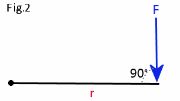
What is Torque?
If two equal forces(F) of act on a body as shown in fig. 1 the body rotates about its axis, which we will call the pivot point (P). The distance from the pivot point to the point where the force acts is called the turning radius (r). The system of forces which is causing this body to rotate is called a couple. The turning moment of a couple is called a torque(T).
Torque is defined as
What is the difference between brake horsepower and torque?Horsepower and torque are commonly used to indicate a measure of an engines performance. Horsepower is the unit of several measurements of power, with power being the rate at which work is done. Notice the units of time in the right hand column (/s /h).
The term horsepower was created by James Watt who used it to help give coal miners an estimate of how many horses his steam engine could replace in terms of pulling power. It was later expanded to include power output of turbines and electric motors. BHP which is commonly associated with engine performance is generally called so due to how the measurement was obtained, this is usually obtained from a type of dynamometer. BHP is a measurement of power and power can be expressed as the amount of work done, or energy transferred, divided by the time interval. Torque on the other hand is simple a measure of twisting force, for example if you use a 1 foot long spanner to release a nut applying 30 pounds of pressure to the end of the spanner then there is 30 ft.lbs of torque at the nut. There is no time involved here, whether the torque is applied for 0.5seconds or 60 minutes the torque is always 30 ft.lbs when applied. To help make this a little clearer, imagine sports car tearing off from the lights, the driver will start of in a low gear rapidly progressing through the gears as the cars speed increases, the gear changes being necessary to maintain the cars acceleration. Starting in the low gears is essential for a quick getaway as the lower gears provide more torque to get the car into motion. Once the car is at a steady 70mph on a flat road the car requires much less torque but more BHP to maintain its speed, this is because; Work = D (distance moved) x F (force applied) and remember; power = work done / time. Although torque and BHP often go hand in hand they are very different in what they are. |
||||||||||||||||

